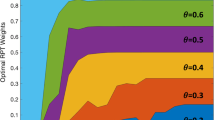Abstract
We consider a problem faced by a procurement manager who needs to purchase a large volume of multiple items over multiple periods from multiple suppliers that provide base prices and discounts. Discounts are contingent on meeting various conditions on total volume or spend, and some are tied to future realizations of random events that can be mutually verified. We formulate a scenario-based multi-stage stochastic optimization model that allows us to consider random events such as a drop in price because of the most favoured customer clauses, a price change in the spot market or a new discount offer. We propose certainty-equivalent heuristics and evaluate the regret of using them. We use our model for three bidding events of a large manufacturing company. The results show that considering most favored customer clauses in supplier offers may create substantial savings that may surpass the savings from regular discount offers.






Similar content being viewed by others
References
Aissaoui N, Haouari M and Hassini E (2007). Supplier selection and order lot sizing modeling: A review. Computers and Operations Research 34 (12): 3516–3540.
Anupindi R and Bassok Y (1998). Approximations for multiproduct contracts with stochastic demands and business volume discounts: Single supplier case. IIE Transactions 30 (8): 723–734.
Avery S (2008). HP looks beyond price discounts. Purchasing Magazine 137 (9): 55.
Bassok Y and Anupindi R (1997). Analysis of supply contracts with total minimum commitment. IIE Transactions 29 (5): 373–381.
Benton W and Park S (1996). A classification of literature on determining the lot size under quantity discounts. European Journal of Operational Research 92 (2): 219–238.
Bichler M, Schneider S, Guler K and Sayal M (2011). Compact bidding languages and supplier selection for markets with economies of scale and scope. European Journal of Operational Research 214 (1): 67–77.
Carbone J (2004). Hewlett-Packard wins for the 2nd time. Purchasing Magazine 133 (14): 34–50.
Chauhan SS, Eremeev AV, Romanova AA, Servakh VV and Woeginger GJ (2005). Approximation of the supply scheduling problem. Operations Research Letters 33 (3): 249–254.
Chopra S and Meindl P (2013). Supply Chain Management: Strategy, Planning, and Operation. Pearson Education: Harlow, UK, 5th edn.
Crama Y, Pascual JR and Torres A (2004). Optimal procurement decisions in the presence of total quantity discounts and alternative product recipes. European Journal of Operational Research 159 (1): 364–378.
DoD-ESI (2012). Blanket Purchase Agreement, DoD Enterprise Software Agreement (ESA), US Department of Defense, Enterprise Software Initiative.
Goossens DR, Maas AJT, Spieksma FCR and van de Klundert JJ (2007). Exact algorithms for procurement problems under a total quantity discount structure. European Journal of Operational Research 178 (2): 603–626.
Gurobi Optimizer Version 5.0 (2012). Gurobi Optimization, Inc., Houston, TX. (software program).
Katz P, Sadrian A and Tendick P (1994). Telephone companies analyze price quotations with Bellcore’s PDSS software. Interfaces 24 (1): 50–63.
Manerba D and Mansini R (2012). An exact algorithm for the capacitated total quantity discount problem. European Journal of Operational Research 222 (2): 287–300.
Mansini R, Savelsbergh M and Tocchella B (2012). The supplier selection problem with quantity discounts and truckload shipping. Omega 40 (4): 445–455.
Montalbano E (2011). Oracle pays $199.5 million to settle GSA claims. InformationWeek, 7 October.
Moody PE (2006). With supply management, technology rules! Supply Chain Management Review May–June: 41–48.
Munson CL and Rosenblatt MJ (1998). Theories and realities of quantity discounts: An exploratory study. Production and Operations Management 7 (4): 352–369.
Murthy N, Soni S and Ghosh S (2004). A framework for facilitating sourcing and allocation decisions for make-to-order items. Decision Sciences 35 (4): 609–637.
Nagali V et al (2008). Procurement risk management (PRM) at Hewlett-Packard company. Interfaces 38 (1): 51–60.
Neumann A and von Hirschhausen C (2004). Less long-term gas to Europe? A quantitative analysis of European long-term gas supply. Zeitschrift für Energiewirtschaft 28 (3): 175–182.
Qin H, Luo M, Gao X and Lim A (2012). The freight allocation problem with all-units quantity-based discount: A heuristic algorithm. Omega 40 (4): 415–423.
Rong Y, Shen ZJ and Yano CA (2012). Cheaper by the pallet? Multi-item procurement with standard batch sizes. IIE Transactions 44 (6): 405–418.
Sadrian A and Yoon Y (1994). A procurement decision support system in business volume discount environments. Operations Research 42 (1): 14–23.
Sample Business Contracts (2012). Amendment to private label agreement and project development and license agreement between Cisco Systems, Inc. and Frontier Software Development, Inc.
Sandholm T (2007). Expressive commerce and its application to sourcing: How we conducted $35 billion of generalized combinatorial auctions. AI Magazine 28 (3): 45–58.
Sherr I (2011). Demand for PCs falters. Wall Street Journal 14 April.
Silver E, Pyke DF and Peterson R (1998). Inventory Management and Production Planning and Scheduling. 3rd edn. Wiley: New York.
Stadtler H (2007). A general quantity discount and supplier selection mixed integer programming model. OR Spectrum 29 (4): 723–744.
Tempelmeier H (2002). A simple heuristic for dynamic order sizing and supplier selection with time-varying data. Production and Operations Management 11 (4): 499–515.
van de Klundert J, Kuipers J, Spieksma F and Winkels M (2005). Selecting telecommunication carriers to obtain volume discounts. Interfaces 35 (2): 124–132.
Xu J, Lu L and Glover F (2000). The deterministic multi-item dynamic lot size problem with joint business volume discount. Annals of Operations Research 96 (1–4): 317–337.
Author information
Authors and Affiliations
Corresponding author
Rights and permissions
About this article
Cite this article
Şen, A., Yaman, H., Güler, K. et al. Multi-period supplier selection under price uncertainty. J Oper Res Soc 65, 1636–1648 (2014). https://doi.org/10.1057/jors.2013.111
Received:
Accepted:
Published:
Issue Date:
DOI: https://doi.org/10.1057/jors.2013.111




